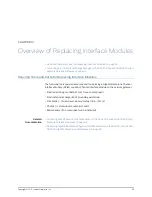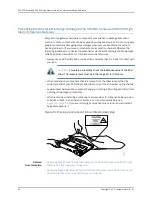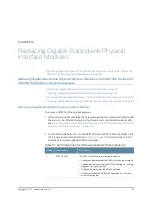
NOTE:
To maintain proper airflow through the services gateway, leave blank
faceplates in place over slots that do not contain GPIMs. Do not remove a
blank faceplate unless you are immediately installing a GPIM in the empty
slot.
To install a GPIM:
1.
Attach an electrostatic discharge (ESD) grounding strap to your bare wrist, and connect
the strap to one of the ESD points on the chassis. For more information about ESD,
see
“Preventing Electrostatic Discharge Damage to the SRX300 Series and SRX550
High Memory Services Gateway” on page 94
.
2.
Grasp the handles on each side of the GPIM faceplate, and align the edges of the
GPIM circuit board with the guide rails at each side of the GPIM slot.
3.
Slide the GPIM into the services gateway until it seats firmly in the device.
CAUTION:
Slide the GPIM straight into the slot to avoid damaging the
components on the GPIM.
4.
Using a Phillips (+) screwdriver, tighten the captive screws on each side of the GPIM
faceplate.
5.
Insert the appropriate cables into the cable connectors on the GPIM.
6.
If necessary, arrange the cables to prevent them from dislodging or developing stress
points:
•
Secure the cable so that it is not supporting its own weight as it hangs to the floor.
•
Place excess cable out of the way in a neatly coiled loop.
•
Use fasteners to maintain the shape of the cable loops.
After the STATUS LED light turns green and glows steadily on, the GPIM is online and
functioning normally. See
for hot-swappable components and their
descriptions.
101
Copyright © 2017, Juniper Networks, Inc.
Chapter 15: Replacing Gigabit-Backplane Physical Interface Modules










































